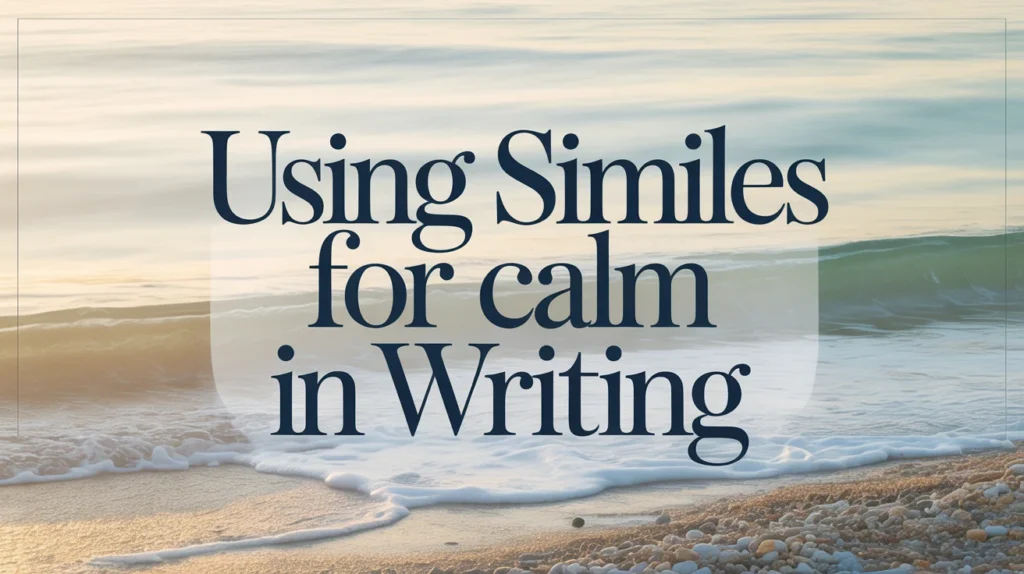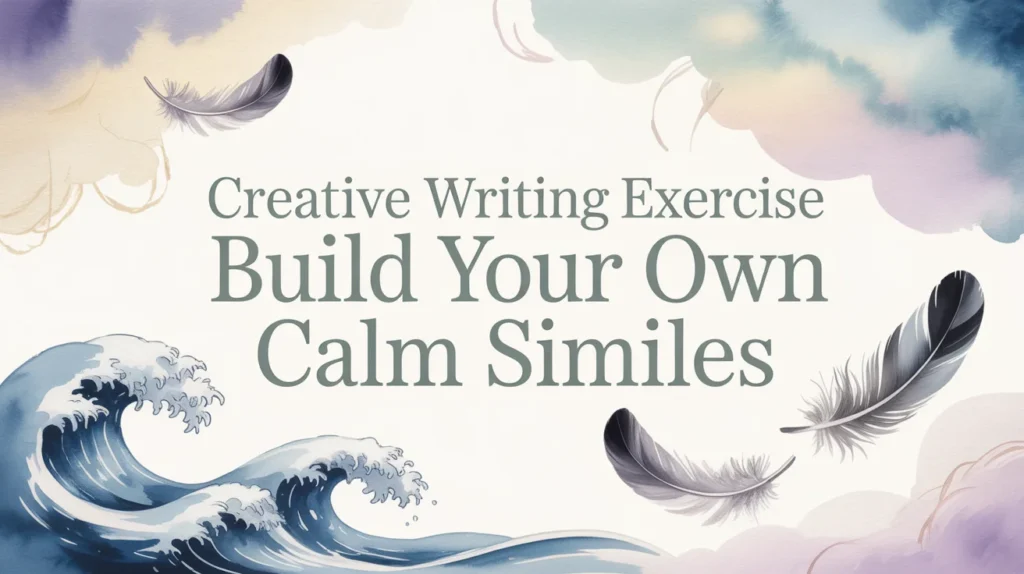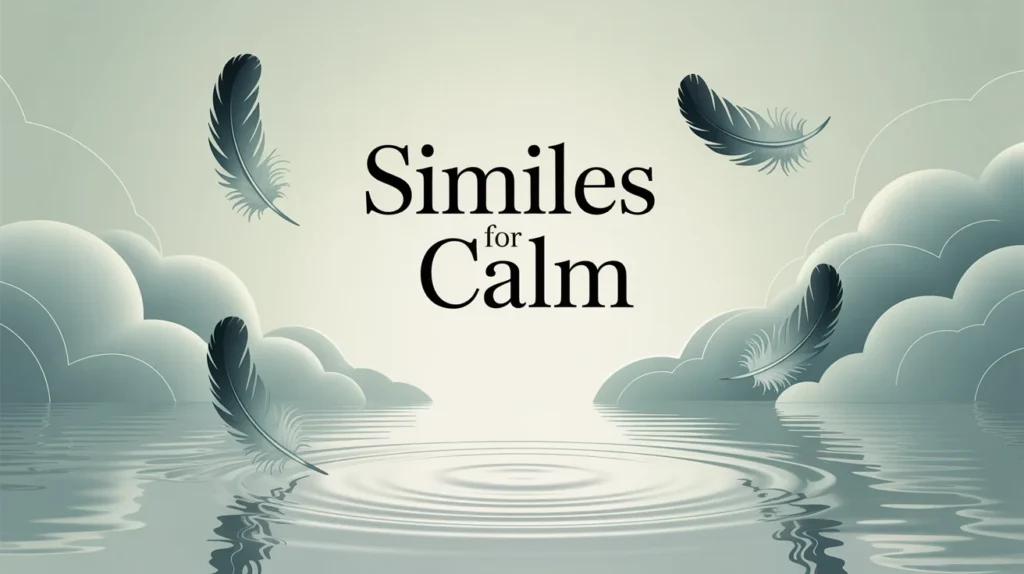There’s something magical about calmness — that feeling of peace that settles the mind like soft waves against the shore. When words fail to describe this serenity, similes for calm step in beautifully.
Similes allow us to paint vivid pictures with language — comparing calmness to nature, emotions, and even silence. They help writers, poets, and everyday speakers express peace in a way that feels alive and relatable.
In this article, we’ll explore dozens of powerful and poetic similes for calm, understand their meanings, and discover how to use them in writing or conversation. Whether you’re crafting poetry, writing essays, or simply want to improve your vocabulary, these comparisons will bring tranquility to your words.
What Is a Simile and Why Use It for Calmness?
Before we dive into examples, let’s get one thing straight: a simile is a figure of speech that compares one thing to another using words such as “like” or “as.”
For example:
“Her mind was as calm as a still lake.”
Here, calmness is compared to a still lake — an image that instantly brings peace to the reader’s imagination.
Why Similes Matter for Describing Calm
Similes for calm do more than just decorate language — they:
- Create vivid imagery that readers can see and feel.
- Enhance emotional connection, especially in poetry or storytelling.
- Simplify complex feelings, making them relatable.
- Improve your writing’s rhythm and tone, adding depth and flow.
So, when you use similes for calm, you’re not just describing peace — you’re inviting the reader to experience it.
Beautiful Nature-Based Similes for Calm

Nature is often the first source of peace that comes to mind. From the stillness of a forest to the quiet of the night sky, here are some nature-inspired similes for calmness.
SimileMeaning / InterpretationAs calm as a still lakePerfect peace, no movement or disturbance.As calm as the morning dewGentle and refreshing calmness.Calm like the moonlit nightSoft, peaceful, and silent atmosphere.Calm as falling snowSilent and soothing peace.Calm like a sunset over the oceanBeautiful tranquility mixed with warmth.Calm as the gentle breezeNatural and effortless peace.As calm as a forest after rainPeaceful renewal and freshness.Calm like a quiet riverFlowing, continuous peace.Calm as the stars in the skyEternal, distant, and serene calmness.Calm as the clouds drifting byEffortless and unbothered state of mind.
When to Use These Similes
These expressions are perfect for:
- Descriptive writing (novels, essays, or poems)
- Meditation guides
- Motivational content
- Character descriptions (in fiction or storytelling)
Emotional and Mental Similes for Calm
Calmness isn’t always about the environment — it’s often about the mind and heart. Here are similes that capture emotional tranquility beautifully.
SimileMeaning / ContextAs calm as a monk in meditationDeep inner peace and focus.Calm like a sleeping childPure, innocent, and untroubled peace.Calm as a steady heartbeatEmotional stability and control.As calm as silence after a stormRelief and recovery after chaos.Calm like a soft whisperGentle and tender peace.Calm as a candle’s steady flamePeace maintained through balance.As calm as acceptanceThe serenity that comes from letting go.Calm like a deep breathSimple and mindful calmness.
How These Similes Connect to Emotional Well-Being
These comparisons often appear in:
- Mental health articles
- Motivational talks
- Personal growth writing
- Therapeutic journaling
Each one encourages mindfulness, emotional control, and a deep sense of inner peace.
Everyday Similes for Calm: Simple Yet Powerful
Sometimes, calmness can be described using familiar, everyday imagery. These similes work beautifully in conversation, essays, and storytelling.
SimileUsage ExampleAs calm as a cat in the sunDescribes someone who is relaxed and carefree.Calm like Sunday morningPerfect for expressing weekend peace.As calm as a frozen pondStillness and composure.Calm like a gentle lullabySoft and soothing calm.Calm as quiet streets at dawnRare and delicate peace.Calm like a cup of tea on a rainy dayComforting tranquility.As calm as someone who knows the truthUnshakable inner certainty.Calm as a book unopenedWaiting silently, undisturbed.
These similes make your writing relatable and warm, especially for lifestyle blogs or creative essays.
Literary and Poetic Similes for Calm
Poets have long celebrated calmness as a symbol of wisdom and balance. Here are literary-style similes that sound artistic and elegant.
SimileTone/UsageCalm as twilight over the fieldsPoetic and romantic.Calm like the lull of time itselfTimeless and profound.Calm as marble in the moonlightStill, strong, and beautiful.Calm like silence before dawnSacred stillness and anticipation.Calm as eternity’s breathSpiritual and endless.Calm like a forgotten dreamNostalgic tranquility.Calm as the hush of the universeCosmic peace.
These similes work perfectly for:
- Poems
- Reflective essays
- Inspirational writing
- Song lyrics or quotes
Using Similes for Calm in Writing

Knowing great similes isn’t enough — you should also learn how to use them effectively.
Here’s how to integrate similes for calm naturally into your writing:
1. Use Them in Character Descriptions
Example:
“She was as calm as a moonlit sea, her voice steady even in chaos.”
2. Add Them in Narrative Moments
Example:
“The city finally rested, as calm as a sleeping child after a long day.”
3. Apply Them in Poetry or Meditation Content
Example:
“Be as calm as the forest after rain — refreshed, silent, and whole.”
4. Blend with Emotion
Pair calm similes with contrasting emotions for impact:
“His anger faded, leaving behind a peace as calm as a frozen lake.”
The Psychology of Calm: Why These Similes Work
Similes for calm resonate deeply because they tap into sensory memory — our ability to recall sights, sounds, and feelings.
When you say “as calm as a still lake,” the reader instantly sees the lake and feels the silence. This connection triggers:
- Mental relaxation
- Emotional empathy
- Creative imagination
That’s why writers, therapists, and teachers often use peaceful similes — they help readers experience serenity through imagery.
Creative Writing Exercise Build Your Own Calm Similes

Want to make your own similes for calm? Here’s a simple formula:
Calm as [peaceful object/scenario].
Examples:
- Calm as a page before the first word.
- Calm as the earth beneath your feet.
- Calm as music fading into silence.
- Calm as the heart that has forgiven.
🧠 Tip: Think about moments, places, or feelings that bring you calm — and turn them into similes. This personal touch makes your writing unique and authentic.
Table: Best Similes for Calmness by Category
CategoryExamplesNature-BasedAs calm as a still lake, Calm as falling snow, Calm like a sunset over the oceanEmotional CalmAs calm as a monk in meditation, Calm like a deep breath, Calm as acceptanceEveryday CalmAs calm as a cat in the sun, Calm like Sunday morning, Calm as quiet streets at dawnPoetic CalmCalm as twilight, Calm like the hush of the universe, Calm as eternity’s breath
SEO Tip: Internal Linking Opportunities
If you’re publishing this article on a blog, you can internally link to:
- “Similes for Peace”
- “Metaphors for Calmness”
- “Idioms for Relaxation”
- “Ways to Describe Serenity in Writing”
This improves SEO ranking and keeps readers exploring your content longer.
FAQs About Similes for Calm
1. What is a good simile for calm?
A great simile for calm is “as calm as a still lake.” It’s simple, vivid, and universally understood.
2. Can similes for calm be used in academic writing?
Yes, but use them sparingly. In essays or reports, they work best in creative introductions or conclusions.
3. What’s the difference between similes and metaphors for calm?
Similes use “like” or “as” to make comparisons (e.g., calm as a river), while metaphors imply the comparison directly (e.g., he is a river of calm).
4. Are there biblical or spiritual similes for calm?
Yes — for example: “as calm as prayer in silence” or “as calm as faith unshaken.” These connect peace to spirituality.
5. How can I teach similes for calm to students?
Use visuals and examples — show them how calm looks (like water or clouds), then let them form their own similes.
Conclusion: The Beauty of Calm in Words
Calmness isn’t just an emotion — it’s an experience. Through the power of similes, we can translate peace into words, helping readers feel it rather than just read it.
From nature-inspired stillness to emotional balance, similes for calm allow language to breathe softly — like the ocean at rest or a candle’s steady glow.
So next time you write, paint your calm — compare it, feel it, and share it. Because in a noisy world, words that whisper peace are the ones that echo longest. 🌿

Olivia Hayes is a digital writing consultant who specializes in grammar for online content. She believes that correct grammar enhances credibility and readability. On GrammerPro, Olivia shares easy-to-follow writing tips for bloggers and professionals alike.

